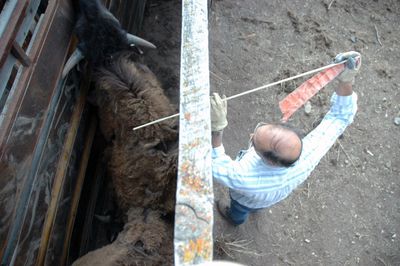Yellowstone bison may get new range to roam
Dozens may head to Wyoming reservation

BILLINGS – State and federal officials have recommended relocating a small herd of bison from Yellowstone National Park to a Wyoming Indian reservation, part of a bid to restore a species that once numbered in the tens of millions.
The 41 animals are now being held in a federal disease quarantine compound in Montana. If Friday’s recommendation is adopted by the state’s wildlife agency, they could be moved to the Wind River Reservation by early April.
Several more batches of bison now under quarantine could be relocated over the next three winters.
Yellowstone contains the largest and most genetically pure bison in the country following intensive hunting that drove the animals to near-extinction in the late 1800s.
Because the park’s bison have a high rate of the disease brucellosis, most bison attempting to leave Yellowstone in recent decades have been shot or slaughtered – more than 1,601 last year alone.
The bison to be relocated were captured in 2005 and 2006. Each has tested negative for exposure to the disease at least nine times. Brucellosis can infect cattle, elk, bison and other animals, causing premature abortions.
Human cases are rare.
“The last thing we want to do is create another endemically infected herd,” said veterinarian Jack Rhyan with the U.S. Department of Agriculture, which runs the quarantine compound in Corwin Springs in cooperation with Montana Fish, Wildlife and Parks.
About half of Yellowstone bison test positive for the disease. However, the seven known transmissions to cattle in the last several years were all tentatively traced to elk. Elk are more numerous and not subject to the same tight restrictions as bison.
Yet fears a latent infection could pop up in relocated bison have stirred opposition from cattle ranchers. Ranchers and farmers also say the bison would knock over fences and tear up crop- and rangeland.
“They get out destroying crops and neighbors’ crops and what have you,” said John Brenden, a state legislator and farmer in Scobey.
Brenden, a Republican, is drafting a bill to block the bison from being moved out of the quarantine. It has not yet been introduced. He added that he would not want the animals moved to Wyoming, either.
Wyoming state veterinarian Walter Cook said his biggest worry was not bison transmitting brucellosis to cattle, but rather disease-free bison becoming infected by elk. That would leave any future Wind River herd in the same quandary as Yellowstone.
He said Wyoming livestock officials planned to meet with tribal leaders in coming weeks to discuss how they would manage the bison.
The Fort Belknap and Fort Peck reservations also have submitted proposals to receive bison from Corwin Springs. Jim Stone with the Intertribal Bison Cooperative said those reservations would hope to receive bison over the next two to three years.
Bison, often called buffalo, once ranged from Mexico to Canada. There are an estimated 20,000-25,000 wild bison remaining in North America – a figure that has changed little since the 1930s, said Keith Aune, a bison biologist with the Wildlife Conservation Society in Bozeman.
Yellowstone’s 3,000 animals make up one of only three herds large enough to be considered biologically sustainable, he said, making it ideal to serve as a “source herd” that could be used to seed new herds across the continent.
“There’s a lot of movement going on to find ways to restore bison not by the millions, but to find some sites that are appropriate where the species would be allowed to exist,” he said.
The selection of the Wind River Reservation of the Northern Arapahoe Tribe was contingent on a site visit and more details from the tribe on how it would manage the animals.
If no suitable site for the quarantined bison is found, they could be returned to Yellowstone National Park or slaughtered.